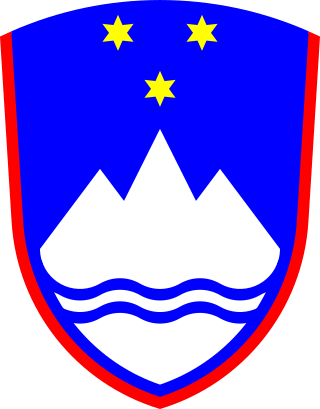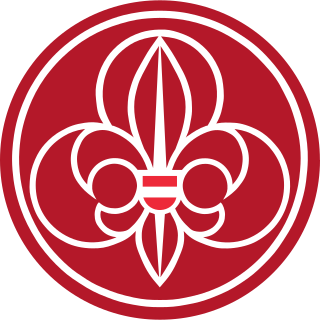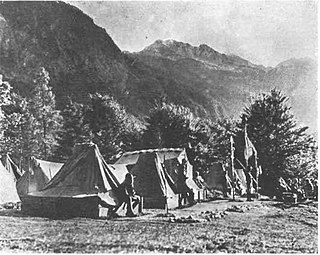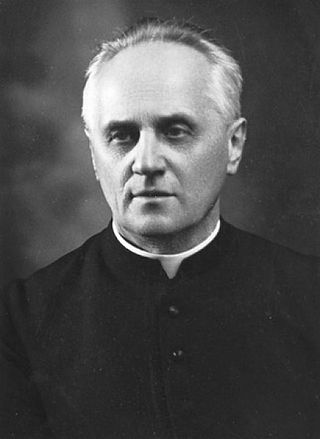International Scout units in Slovenia
In addition, there are USA Girl Scouts Overseas in Ljubljana, serviced by way of USAGSO headquarters in New York City.
Scouting (and Guiding) in Slovenia is served by three associations:
Despite the split membership in the different world organizations, ZTS and ZSKSS are both coeducational. Participation in WOSM and WAGGGS events is open to individual members of both associations.
Slovene minorities in the adjacent countries are served by two organizations:
The Slovene noun for a single Scout is tabornik or skavt depending on the organization.
The history of Scouting in Slovenia dates to when Slovenia was a part of the former Kingdom of Yugoslavia, and possibly back to 1915. In 1922, a meeting of Sokol, an important political and sporting movement in Yugoslavia, took place in Ljubljana, and Bosnian and Serbian Scouts attended. Scouting was officially established in Slovenia in October 1922, when a large number of Scout groups in Slovenia contributed to the establishment of the Scout Parish for Croatia and Slovenia, founded in Osijek. The Slovenia Scout Region was established in early 1923 in Ljubljana. The first Slovene Scout and Guide camp was organized during the summer of 1923 at a Slovene alpine resort. Scouting in Slovenia was officially dissolved on June 10, 1941 because of World War II. Just prior to the dissolution, there were 1,380 members of the Slovene Scout Organization.
Scouting in the Socialist Federal Republic of Yugoslavia was coopted by the Tito government in 1950, at which time WOSM membership was forfeited. In 1951, individual Scout associations were founded in all then-Yugoslav republics, as branches of Savez Izviđača Jugoslavije. The first of these was Zveza tabornikov Slovenije (ZTS) in Slovenia.
Slovene Scouting also continued in exile, at first in refugee camps, and afterwards in Argentina and Canada, and in the Slovene ethnicity nearby Gorizia and Trieste. The Movement also revived among the Slovene ethnic groups in neighboring countries: The Slovene Carinthian Scouts (in 1957) in Austria (today part of the Pfadfinder und Pfadfinderinnen Österreichs); the Slovene Scouts of Trieste (Slovenske Zamejske Skavtske Organizacije (SZSO) Trst) in 1951 for boys and in 1958 for girls; and the Slovene Scouts of Gorizia (SZSO - Slovenski goriški skavti), in 1963 for girls and 1964 for boys.
In 1984, a secondary school student from Ljubljana, Peter Lovšin, became acquainted with the Scout Movement. He decided to begin apolitical Scouting in Ljubljana. In the summer of 1985 he went to camp with Scouts of Gorizia, and in 1986 he made the Scout Promise as one of their rank. In the same year he gathered a group of young people around him in one of the Catholic parishes of Ljubljana, with assistance from Scouts of Trieste and Gorizia. The group was growing and in autumn 1988 moved to another parish of Ljubljana. On Saint George day in 1989, 12 boys and girls made the Scout Promise, and by 1990, there were 21 Girl Guides and 18 Boy Scouts. The Catholic Scout Movement began to spread all over Slovenia. On March 31, 1990, the Združenje slovenskih katoliških skavtinj in skavtov (ZSKSS) was founded. The first legal Scout Promises were made by 29 Girl Guides and Boy Scouts, in a suburb of Ljubljana on May 20 of that year. Officially the ZSKSS was registered on Sunday, October 22, 1992.
In 1994, ZTS became the 138th member of WOSM. Two years later, ZSKSS was accepted as associate member of WAGGGS. ZSKSS received full membership in WAGGGS in 1999.
Associazione Guide e Scouts Cattolici Italiani, specially leaders from Friuli-Venezia Giulia, has been actively involved in the growth of Scouting in Slovenia.
In addition, there are USA Girl Scouts Overseas in Ljubljana, serviced by way of USAGSO headquarters in New York City.

Kobarid is a settlement in Slovenia, the administrative centre of the Municipality of Kobarid.

Trbovlje is Slovenia's tenth-largest town, and the seat of the Municipality of Trbovlje. It is located in the valley of a minor left tributary of the Sava River in the Central Sava Valley in central-eastern Slovenia.

The Slovene coat of arms is an emblem that consists of a red bordered blue shield on which there is a stylised white Mount Triglav, under which there are two wavy lines representing the sea and the rivers of the country. Above Mount Triglav, there are three golden six-pointed stars representing the Counts of Celje. It was designed in 1991 by Marko Pogačnik and adopted on 24 June 1991.

Pfadfinder und Pfadfinderinnen Österreichs is the largest Scouting and Guiding organization in Austria and the only one approved by World Association of Girl Guides and Girl Scouts (WAGGGS) and the World Organization of the Scout Movement (WOSM). The association claims more than 300 troops with more than 85,000 Scouts nationwide. WOSM and WAGGGS give quite smaller membership values for the PPÖ: 27,274 members in WOSM and 10,508 members in WAGGGS.

The Ring deutscher Pfadfinderverbände was the German national Scouting organization within the World Organization of the Scout Movement (WOSM). It served 115,944 members.

The Ring Deutscher Pfadfinderinnenverbände was the German national Guiding organization within the World Association of Girl Guides and Girl Scouts (WAGGGS). It served 47,688 members.

Zveza tabornikov Slovenije is the national Scouting organization of Slovenia. Scouting in Slovenia was started in 1922; ZTS was founded in 1951 as sub-association of Savez Izviđača Jugoslavije. It became independent in 1991 and the 138th member of the World Organization of the Scout Movement in 1994. The coeducational association has 5,179 members.

Slovenian Catholic Girl Guides and Boy Scouts Association is the national Guiding organization of Slovenia.

The Association of Belarusian Guides is the Belarusian member organization of the World Association of Girl Guides and Girl Scouts (WAGGGS), with a membership of 1,274 Girl Guides.

United Slovenia is the name originally given to an unrealized political programme of the Slovene national movement, formulated during the Spring of Nations in 1848. The programme demanded (a) unification of all the Slovene-inhabited areas into one single kingdom under the rule of the Austrian Empire, (b) equal rights of Slovene in public, and (c) strongly opposed the planned integration of the Habsburg monarchy with the German Confederation. The programme failed to meet its main objectives, but it remained the common political program of all currents within the Slovene national movement until World War I.

The Slovene Littoral, or simply Littoral, is one of the traditional regions of Slovenia. The littoral in its name – for a coastal-adjacent area – recalls the former Austrian Littoral, the Habsburg possessions on the upper Adriatic coast, of which the Slovene Littoral was part. Today, the Littoral is often associated with the Slovenian ethnic territory that, in the first half of the 20th century, found itself in Italy to the west of the Rapallo Border, which separated a quarter of Slovenes from the rest of the nation, and was strongly influenced by Italian fascism.
Scouting and Guiding in Italy consists of several associations and federations, including more than 225,000 male Scouts and female Guides.

The Bund der Pfadfinderinnen und Pfadfinder (BdP) (German Association of Guides and Scouts) is the largest non-denominational, co-educational Scout and Guide association in Germany. Through its membership in the Ring deutscher Pfadfinder*innenverbände, it is part of the World Organization of the Scout Movement and the World Association of Girl Guides and Girl Scouts. Founded in 1976, the association serves about 30,000 members nationwide.
The Slovene Scouts and Guides in Carinthia is the Scout and Guide association of the Slovene-speaking minority in Carinthia. It is affiliated to the Carinthia division of the Boy Scouts and Girl Guides of Austria as a Scout group. The association is coeducational.

The Slovenska Zamejska Skavtska Organizacija is a Catholic Scouting and Guiding association serving Slovenes in Friuli-Venezia Giulia, Italy. SZSO is affiliated to the Associazione Guide e Scouts Cattolici Italiani (AGESCI), the largest Scout association in the country.

Engelbert Besednjak was a Slovene Christian Democrat politician, lawyer and journalist. In the 1920s, he was one of the leaders of the Slovene and Croat minority in the Italian-administered Julian March. In the 1930s, he was one of the leaders of Slovene anti-Fascist émigrés from the Slovenian Littoral, together with Josip Vilfan, Ivan Marija Čok and Lavo Čermelj.

Lambert Ehrlich was a Carinthian Slovene Roman Catholic priest, political figure, and ethnologist.
Slovene minority in Italy, also known as Slovenes in Italy is the name given to Italian citizens who belong to the autochthonous Slovene ethnic and linguistic minority living in the Italian autonomous region of Friuli-Venezia Giulia. The vast majority of members of the Slovene ethnic minority live in the Provinces of Trieste, Gorizia, and Udine. Estimates of their number vary significantly; the official figures show 52,194 Slovenian speakers in Friuli-Venezia Giulia, as per the 1971 census, but Slovenian estimates speak of 83,000 to 100,000 people.
The Association of Fighters of Yugoslavia, known as Boj, was a Yugoslav nationalist organization in the Drava Banovina (Slovenia) of the Kingdom of Yugoslavia, active between 1930 and 1935. It was established in 1929 as the Union of Slovene Soldiers, then renamed in 1930 to Union of Fighters. The movement supported King Alexander's royal dictatorship. It was approved by the Drava Banovina administration in 1931. In late 1933, the organization was renamed as the "Association of Fighters of Yugoslavia". It was merged along with other organizations, such as Yugoslav Action that was based mainly in Croatia, and groups surrounding the magazines of Zbor ("Council") and Otadžbina ("Homeland") based in Belgrade, and Budjenje ("Awakening") in Zrenjanin, to form the Yugoslav National Movement led by Dimitrije Ljotić in early 1935.
The Deutschsprachige Konferenz der Pfadfinderverbände (DSK) is the international community of Scouting organizations in the German-speaking countries, an umbrella of Central European organizations within the World Organization of the Scout Movement or World Association of Girl Guides and Girl Scouts, including Austria, Luxembourg, Switzerland, France (Alsace), South Tyrol (Italy), the German-speaking Community of Belgium, and Liechtenstein. Its members are internationally recognized German Scouting associations and the minority German-speaking Scouting associations.